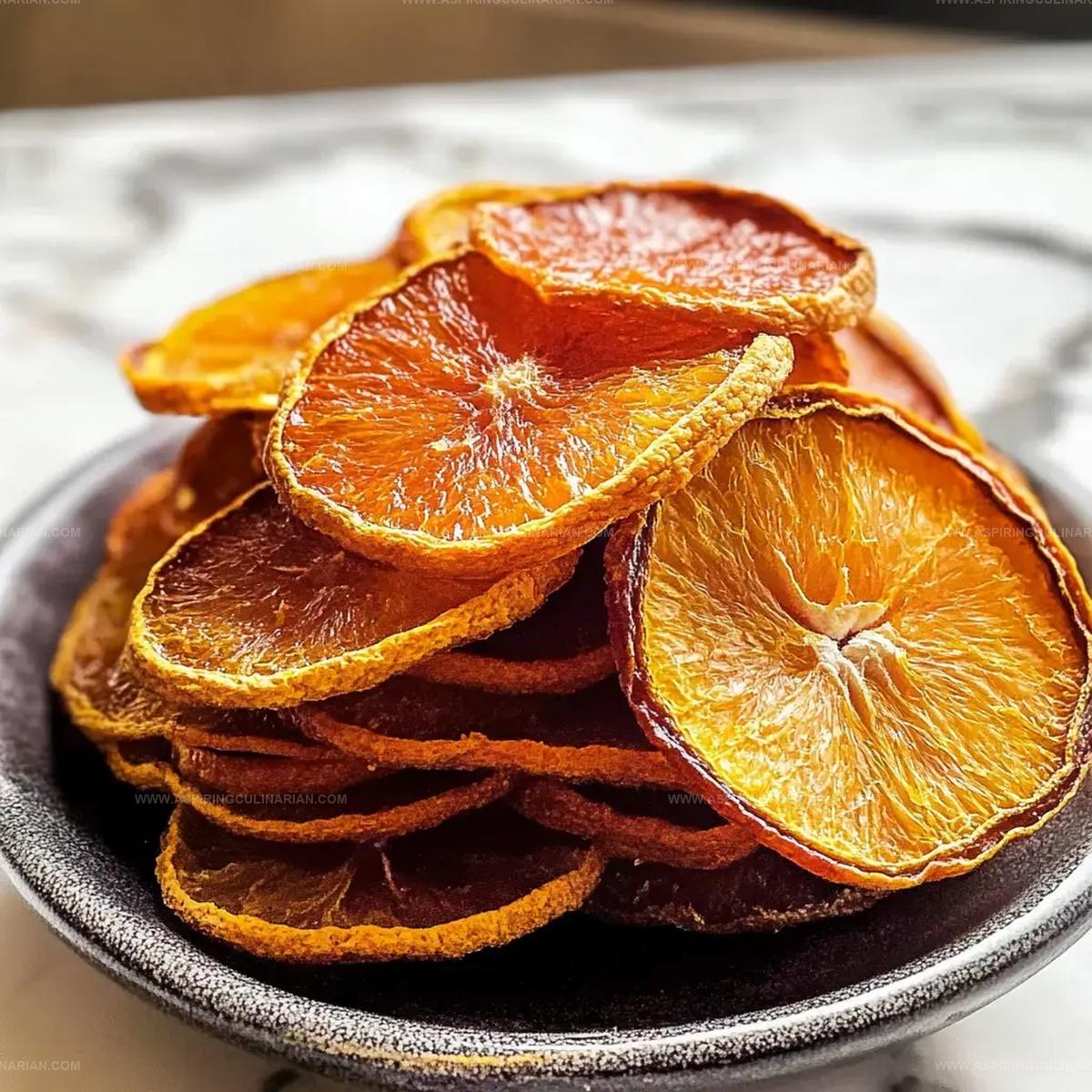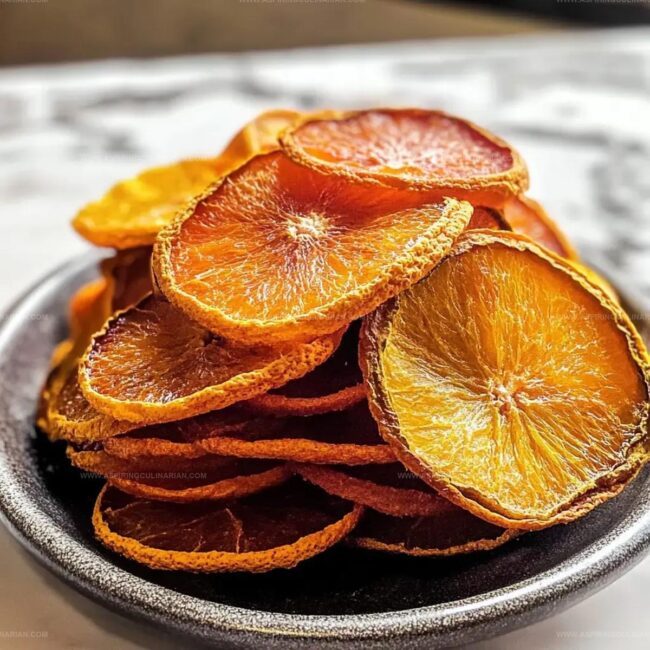Magical Dried Orange Slices Recipe: A Zesty Kitchen Delight
Crafting dried orange slices brings a burst of citrusy magic to your kitchen.
These vibrant orange slices dehydrate into delightful, translucent gems that sparkle with natural sweetness.
Slice oranges thin and even for the best results.
The process transforms ordinary citrus into elegant, versatile garnishes perfect for cocktails, teas, and baked goods.
Homemade dried orange slices add a sophisticated touch to your culinary creations.
Rich with intense orange flavor, these delicate slices can elevate desserts, decorations, and drink presentations.
Embrace this simple technique and unlock a world of zesty possibilities.
Why Dried Orange Slices Are Both Beautiful and Useful
What Goes Into Dried Orange Slices for Garnish
Main Ingredients:Kitchen Tools:Oven Equipment:Simple Steps for Drying Orange Slices at Home
Step 1: Prepare Oven and Workspace
Warm up your oven to 250°F (120°C).
Cover a baking sheet with parchment paper to create a perfect drying surface.
Grab a sharp knife and clean cutting board for precise slicing.
Step 2: Create Perfect Orange Rounds
Select fresh, firm oranges.
Wash the fruit thoroughly.
Slice oranges into delicate, uniform rounds approximately 1/4 inch thick.
For best results, use a sharp serrated knife and make smooth, even cuts.
Step 3: Remove Excess Liquid
Pat orange slices gently with clean paper towels.
Press softly to absorb surface moisture without damaging the fruit’s delicate structure.
This step ensures crisp, beautiful dried slices.
Step 4: Arrange Slices Strategically
Place orange rounds in a single layer on the prepared baking sheet.
Ensure slices do not overlap or touch each other.
Proper spacing allows even air circulation and consistent drying.
Step 5: Begin Slow Drying Process
Slide baking sheet into the preheated oven.
Set a timer and check slices every hour.
Carefully flip each slice to promote uniform drying and prevent uneven browning.
Step 6: Monitor Drying Progress
Watch for signs of excessive browning.
If slices darken too quickly, lower oven temperature slightly.
Consistent, gentle heat creates perfect dried orange decorations.
Step 7: Determine Perfect Dryness
Dried slices are ready when they feel crisp and slightly leathery.
They should have no visible moisture and maintain a translucent appearance.
Total drying time typically ranges between 2-4 hours.
Step 8: Cool and Preserve
Remove baking sheet from oven.
Allow orange slices to cool completely at room temperature.
Store in an airtight container in a cool, dark place.
Properly dried slices can last several months.
Tips for Getting Dried Orange Slices Just Right
Ways to Use Dried Orange Slices Beyond Garnish
Serving Ideas for Dried Orange Slices
Storing Dried Orange Slices for Long-Lasting Freshness
FAQs
Yes, you can use any variety of oranges like navel, Valencia, or blood oranges. Choose fresh, firm oranges with minimal blemishes for best results.
Aim for consistent slices around 1/4 inch thick. Using a sharp knife or mandoline slicer helps achieve uniform thickness, which ensures even drying.
While primarily used for decorative purposes like garnishing cocktails or holiday wreaths, they can be eaten as a crispy, slightly bitter snack. They’re often used in baking and tea blends too.
Print
Dried Orange Slices Recipe
- Total Time: 3 hours 15 minutes
- Yield: 1 1x
Description
Homemade dried orange slices sparkle with Mediterranean sunshine, offering a simple yet elegant kitchen craft. Crisp citrus rounds deliver rich natural sweetness perfect for garnishing desserts, cocktails, or enjoying as a delightful snack you’ll savor.
Ingredients
Main Ingredients:
- 4 oranges
Secondary Ingredients:
- 0 other ingredients
Preparation Ingredients:
- 0 other ingredients
Instructions
- Prepare the workspace by positioning an oven rack in the middle and heating to 250F (120C). Cover a baking sheet with parchment paper for optimal drying surface.
- Carefully slice oranges into uniform, translucent rounds approximately 1/4 inch thick, ensuring consistent width for even dehydration.
- Gently press paper towels against orange slices to absorb surface moisture, preventing excess liquid during the drying process.
- Position orange slices in a single, non-overlapping layer across the prepared baking sheet, allowing adequate air circulation.
- Place baking sheet in preheated oven and dry for approximately 3 hours, rotating the sheet and flipping slices every 60 minutes to promote uniform dehydration.
- Monitor orange slices closely, adjusting oven temperature downward if edges begin to darken or caramelize too quickly.
- Evaluate slice readiness by checking for complete moisture removal and a crisp, leathery texture that maintains the orange’s translucent appearance.
- Extract baking sheet from oven and allow orange slices to cool completely at room temperature before storing in an airtight container or using for decorative purposes.
Notes
- Select firm, fresh oranges with minimal blemishes for the best drying results.
- Pat orange slices thoroughly with paper towels to reduce moisture and prevent soggy texture.
- Use a sharp mandoline or serrated knife to create consistent, even slice thickness for uniform drying.
- Try different citrus varieties like blood oranges or tangerines for unique color and flavor variations.
- Sprinkle light cinnamon or sugar before baking to enhance aromatic qualities and create decorative edges.
- Store completely cooled dried orange slices in airtight glass containers away from direct sunlight to maintain crispness.
- Perfect for cocktail garnishes, holiday decorations, wreath making, and elegant table settings.
- Prep Time: 15 minutes
- Cook Time: 3 hours
- Category: Snacks, Desserts
- Method: Baking
- Cuisine: American
Nutrition
- Serving Size: 1
- Calories: 80
- Sugar: 16 g
- Sodium: 0 mg
- Fat: 0 g
- Saturated Fat: 0 g
- Unsaturated Fat: 0 g
- Trans Fat: 0 g
- Carbohydrates: 21 g
- Fiber: 4 g
- Protein: 1 g
- Cholesterol: 0 mg





Nathaniel Brooks
Founder & Recipe Developer
Expertise
Farm-to-table cuisine, Seasonal recipe development, Culinary storytelling
Education
Ivy Tech Community College – Indianapolis, IN
Culinary Arts / Hospitality Administration & Events
Focused on hands-on training in classical and modern culinary techniques.
Nathaniel’s story starts in the foothills of the Appalachian Mountains, where farm stands, backyard gardens, and old family recipes shaped his love for real food. After graduating from Ivy Tech Community College in Indianapolis, he spent years working in farm-to-table kitchens, learning how to turn local, seasonal ingredients into something memorable.
Today, Nathaniel pours that same spirit into every single recipe on Aspiring Culinarian – recipes that feel real, comforting, and connected to the land. When he’s not in the kitchen, you’ll find him foraging wild herbs, chasing sunsets with his camera, or writing about the flavors that shaped his roots.